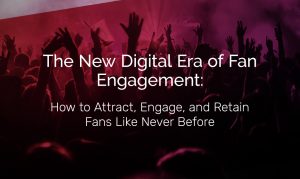Whether it’s a compelling blog post, an informative video, or a captivating social media campaign, content is the conduit through which brands connect, educate, and influence their target consumers. As businesses strive to stand out amidst the online noise, the role of content marketing has become increasingly pivotal.
But building a robust content marketing operation doesn’t happen instantaneously. It’s an everlasting journey driven by strategic planning, resource allocation, creativity, and a keen understanding of audience behavior. Each development stage will represent a new level of content marketing maturity.
We’ve compiled a new way of measuring and addressing the different levels of maturity that are pit stops along the way. In our Content Marketing Maturity Map, we refer to these five levels of maturity as “landmarks” – and they’re all represented by familiar architectural icons. An effective yet fun way to understand and remember each level as your strategy develops.
Download this post by entering your email below
What Is the Content Marketing Maturity Model?
The content marketing maturity model is a metric that can help you make content marketing decisions. The model’s name uses the word “maturity”; another term that fits might be “expertise.”
Essentially, this model measures how much your end-to-end process for content development uses proven methodology. It’s a concept that got its start in the 1980s as a model that helped developers create and test their software. Today, it enables marketers to better understand their maturity level when creating content.
Predictability is an ongoing issue in content marketing because trends change, making it difficult to judge the value of what is published. The maturity of your content development process can improve results, though. The maturity model helps you identify your current level and where you might improve.
Rock Content’s Content Maturity Map
1. Stonehenge: Reactive
At the initial stage of content marketing maturity, known as reactive content marketing, businesses resemble the scattered pieces of an unfinished puzzle. Much like a jigsaw puzzle lacking a clear picture to guide its assembly, this phase is characterized by an unplanned and sporadic approach to content creation.
Stonehenge’s cobbled-together appearance reflects the scattered nature of reactive content creation. Just as the monument’s stones appear disconnected, businesses at this stage might produce content pieces that lack a consistent brand voice or narrative. The content’s effectiveness is difficult to measure, as there’s no strategic framework guiding its creation or evaluating its impact.
Transitioning from this reactive stage marks a critical step towards content marketing maturity. Organizations recognize the need for a more structured and purpose-driven approach, paving the way for the subsequent stages of development. The journey from reactive to proactive content strategies lays the foundation for growth and optimization in the evolving landscape of content marketing.
2. Tower of Pisa: Proactive
Advancing from the initial reactive stage, the next is proactive content marketing. It is akin to the way the Tower of Pisa represents architectural progression despite its renowned tilt. At this stage, businesses are more purposeful in their content creation efforts, though the strategy might still be somewhat speculative.
The Tower of Pisa stage symbolizes a move towards planned content creation, much like the architectural vision behind the iconic tower’s construction. Just as architects attempted innovative solutions to rectify the tower’s tilt, content marketers at this level strategize to engage their audience more effectively. There’s a recognition of the need for a structured content calendar that aligns with broader marketing goals and audience interests.
However, the content strategy might not be flawlessly aligned. There is a learning curve as organizations grapple with finding the right balance between consistency and experimentation. Content creators seek to anticipate audience needs and preferences, but these assumptions might not always yield accurate results.
3. Big Ben: Correlative
The third stage of maturity is correlative content marketing, represented by the iconic Big Ben. This stage signifies the synchronization between content efforts and wider organizational goals, where accountability and ROI take center stage.
The correlative stage emphasizes a data-driven approach. Through analytics and attribution models, organizations gain insights into which content pieces contribute most significantly to their goals. This stage embodies a transition from speculation to informed decision-making, with content strategies adapting based on actual audience interactions and preferences.
Furthermore, the integration of content marketing with broader organizational functions becomes evident. Collaboration between marketing, sales, and customer service ensures a cohesive customer journey. This synergy mirrors the way Big Ben’s chimes resonate across London, creating a harmonious and impactful experience.
4. CN Tower: Adaptative
Adaptive content marketing embodies adaptability, versatility, and a relentless focus on achieving results. Just as the CN Tower stands tall and versatile against Toronto’s skyline, businesses at this stage exhibit a profound ability to navigate dynamic landscapes and deliver measurable outcomes.
Metrics extend beyond engagement rates and conversions to encompass deeper insights such as customer sentiment, content virality, and multi-channel attribution. Just as the CN Tower’s observation decks offer panoramic views, content marketing teams gain a holistic perspective of their efforts’ impact and adjust their strategies accordingly.
The adaptative stage also emphasizes a relentless pursuit of results. Content marketing efforts are closely aligned with tangible outcomes, whether that be revenue growth, customer loyalty, or market share expansion. The ability to adapt, pivot, and drive results positions them as industry leaders, ready to capitalize on emerging trends and continuously enhance their content strategies for sustained success.
5. Taj Mahal: Predictive
Lastly, the pinnacle of maturity, predictive content marketing, is embodied by the majestic Taj Mahal. This final stage signifies a level of sophistication akin to the architectural marvel itself – a predictive content marketing strategy that seamlessly intertwines personalization, automation, and a profound understanding of audience preferences.
Organizations have mastered the ability to anticipate audience behavior, preferences, and needs. Armed with sophisticated data analytics and AI-powered insights, content creators craft content journeys that seamlessly guide individuals through their purchase decisions.
Reaching the Taj Mahal stage is the realization of content marketing’s true potential. It signifies an advanced understanding of not just what works, but why and how it works. The ability to predict audience behaviors, personalize experiences, and automate delivery elevates content marketing to a strategic differentiator, contributing to profound brand loyalty and business growth.

Click here to find out which landmark your content strategy lands on, and learn how to progress from one level to the next to eventually build a content marketing operation as awe-inspiring as the Taj Mahal.
How to Evolve from One Maturity Stage to the Other?
Start by determining what stage you have reached on the content maturity map. Ask yourself some questions to gauge your progress:
- Are content marketing choices made intentionally or randomly?
- Are business goals part of the decision-making process?
- Is our content a brand asset or just something to fill space?
- Do we build our content around our target audience or user behavior?
- Do we use multiple channels when publishing content?
- Do we consider the customer journey and experience when developing our content strategy?
- What is the impact of content marketing on the business? Is there better lead generation, more traffic on the website, or an increase in revenue?
From there, you can determine what it takes to advance to the next stage.
From reactive to proactive
Defining your brand objectives is the key to leveling up from stage one to stage two. This will give you the foundation needed to develop a more proactive stance for content marketing. You can create teams to produce your content and measure performance to see if those objectives are met.
From proactive to correlative
You can jump from proactive to correlative by defining a content strategy based on the customer journey. The customer journey is the path people take from first thinking about buying a product or service to doing so. What interactions occur to get them to that point?
For instance:
- Do they search Google? – If so, you might need to focus more on SEO, find ways to drive traffic to your website and increase the brand’s internet presence.
- Do they go on social media? – Maybe you could benefit from pay-per-click ads and active social media pages.
List all of the potential touchpoints and then rate their importance. This gives you a path to follow when designing your content distribution.
From correlative to adaptive
You can bump up from correlative to adaptive by establishing key metrics that help measure the success of your content marketing and the impact it has on your business. This will help you understand if you are using the right marketing assets and channels.
You’ll be able to measure the return on your effort and what tweaks might make it even better. Each tweak takes you that much closer to reaching the top level.
From adaptive to predictive
Predictive should be your ultimate goal because it can deliver the best results. This step requires some investment, like getting top-notch writing talent and a professional strategist on board.
The right marketing partner, like WriterAccess, also provides automation that makes the process more effective and personalized. At WriterAccess, you can use AI to help perform keyword research, create customer personas, and develop topics. Combine that with some of the best writing talent in the world, and you are showing the utmost maturity in your content creation process.








